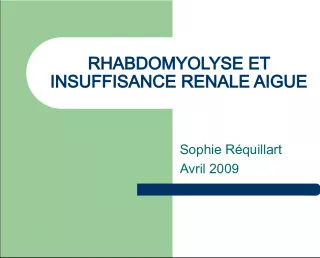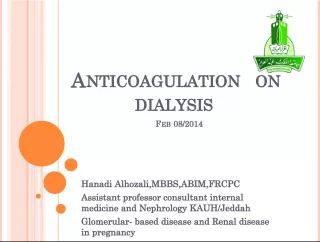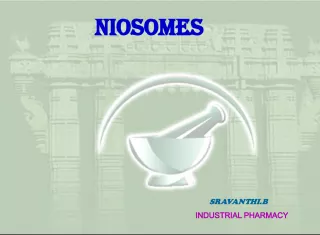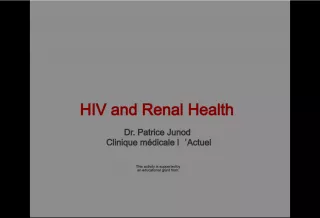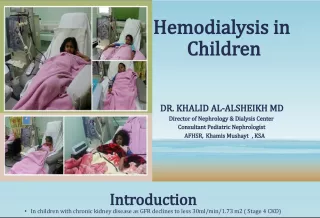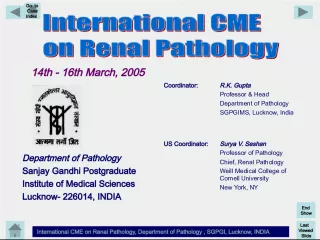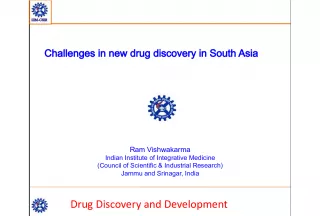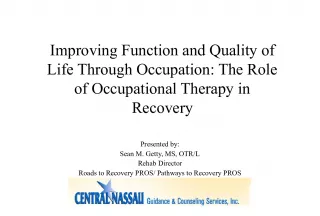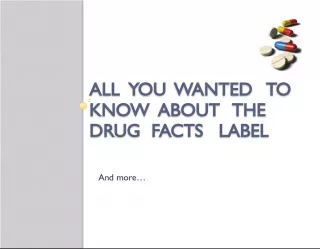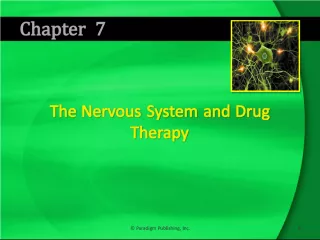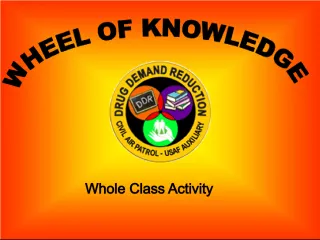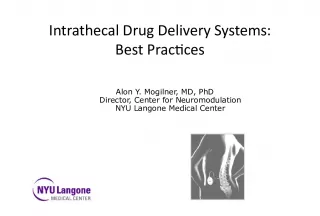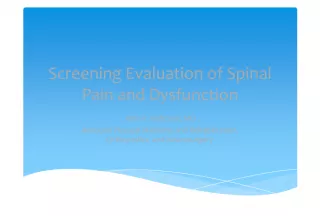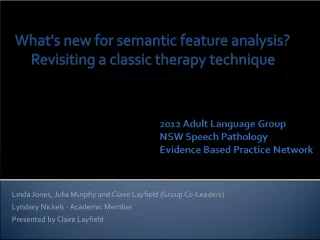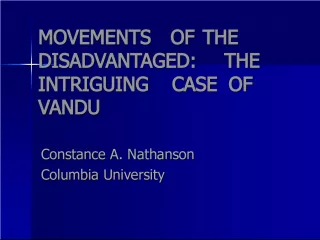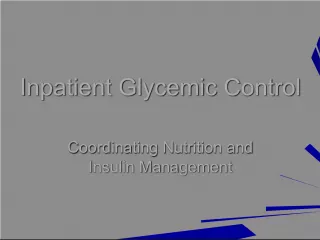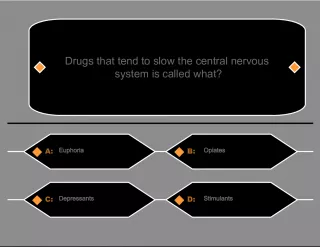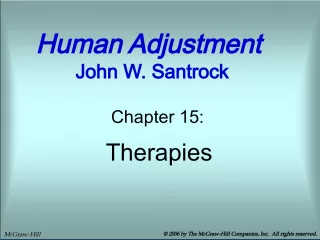Renal Dysfunction and Drug Therapy
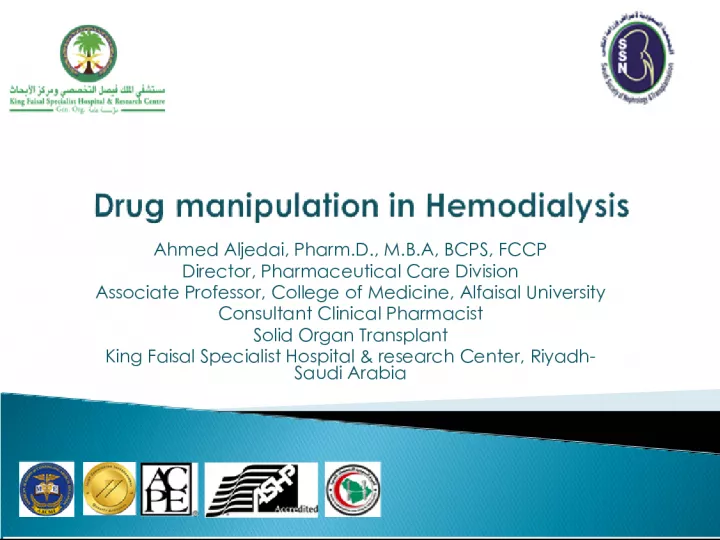

Renal disease alters drug pharmacokinetics and pharmacodynamics, which can lead to toxic metabolite accumulation and increased sensitivity to drugs. Careful dosing and monitoring are crucial in preventing adverse drug reactions in these patients.
- Uploaded on | 7 Views
-
 sandra
sandra
About Renal Dysfunction and Drug Therapy
PowerPoint presentation about 'Renal Dysfunction and Drug Therapy'. This presentation describes the topic on Renal disease alters drug pharmacokinetics and pharmacodynamics, which can lead to toxic metabolite accumulation and increased sensitivity to drugs. Careful dosing and monitoring are crucial in preventing adverse drug reactions in these patients.. The key topics included in this slideshow are . Download this presentation absolutely free.
Presentation Transcript
1. Ahmed Aljedai, Pharm.D., M.B.A, BCPS, FCCP Director, Pharmaceutical Care Division Associate Professor, College of Medicine, Alfaisal University Consultant Clinical Pharmacist Solid Organ Transplant King Faisal Specialist Hospital & research Center, Riyadh- Saudi Arabia
2. I have no actual or potential conflict of interest in relation to this presentation or program.
3. Without careful dosing and therapeutic drug monitoring in patients with renal dysfunction, accumulation of drugs/toxic metabolites can occur Renal disease affects the pharmacokinetic as well as pharmacodynamic effect of drugs Uremia can alter drug disposition, protein binding, distribution and elimination (PK), and can also increase sensitivity to drugs (PD)
4. P ha rm a c o ki ne tics Phar m a c o k i n e t ic f a ct o r s t o c on s ider in drug di st ribu t i o n: D r u g in tiss u e Drug absorbed (oral, IV, rectal, lung) Drug Metabolism (liver, kidney, GI tract) E li m i na ti o n D r u g in b l ood U r i ne , B ili a r y , Di a l y sis, Lun g S kin D r u g in o t her f l u i d s GI, g a st r o i n t e sti n a l. I V , i n t r a v enou s.
5. Bi oa v a il ab ility Bioavailability is the fraction of the administered dose that reaches the systemic circulationbioavailability is 100% for IV injections Drug bioavailability varies more in renal patients compared to healthy patients: Decreased GI Absorption Alkaline environment (from salivary urea converted to ammonia by urease) will minimize absorption of medications that require an acidic environment (such as oral iron) Slowed absorption rates due to reduced peristalsis Slowed absorption due to bowel wall edema Phosphate binders (such as Ca and Al) that form complexes with drugs, making them insoluble for absorption
6. Altered First-Pass Metabolism Decreased biotransformation resulting in increased amounts of active drug in systemic circulation Impaired plasma protein binding resulting in more free drug available for hepatic metabolism
7. V o l u me o f Dr u g Distri bu ti o n Volume of distribution (Vd): the amount of drug in the body divided by the concentration in the blood. Lipid soluble drugs (e.g. diazepam) or highly tissue-bound drugs (e.g. digoxin) have very high volumes of distribution Lipid insoluble drugs, such as neuromuscular blockers, remain in the blood and have a low volume of distribution Extracellular volume overload may increase the apparent volume of distribution of highly water soluble drugs, thus usual doses may result in low plasma levels in volume overloaded patients Muscle-wasted patients often have decreased apparent volume of distribution, and thus higher plasma levels
8. Pr o t e in Bi nd i ng Plasma protein binding is a key determinant of Vd Drugs that are highly protein bound will stay in the vascular space and have a low Vd Protein bound drugs are largely inactive Renal failure may increase or decrease protein binding Reduced plasma protein binding may result in more free drug available at the site of drug action/toxicity Organic acids that accumulate in renal failure will compete with acidic drugs for protein binding, and a larger fraction of acidic drugs will exist in the unbound active state (salicylate, warfarin, sulfonamides, phenytoin) . Total and unbound plasma phenytoin concentrations should be measured when monitored Basic drugs will bind more readily to non-albumin proteins and there may be increased protein binding Low albumin will result in decreased binding and more active drug
9. Dr u g M e t abo lism/R ena l Elimi na ti o n Clearance of a drug: the volume of plasma from which the drug is completely removed per unit of time In dialysis patients, drug metabolism is unpredictable Non-renal elimination (i.e., hepatic metabolism) may compensatorily increase, remain unchanged, or decrease: Reduction and hydrolysis are slowed Most drugs undergo hepatic biotransformation to more polar, but less pharmacologically active, compounds that require intact renal function for elimination Accumulation of active or toxic metabolites from parent compounds can occur (examples include procainamide, allopurinol, and meperidine) I n ES RD , d r ug s ma y acc u m ul a te du e to i m p a i re d glo mer ul a r f il t ra t ion , d ecrease d re n a l t ubul a r secre t ion , a nd i m p a i re d re n a l e pi t h e li a l ce l l me t a boli s m
10. Dr u g D o si n g Load i n g D o se Loading doses are useful for drugs that are eliminated from the body relatively slowly Such drugs need only a low maintenance dose in order to keep the amount of the drug in the body at the target level Without loading, it would take longer for the amount of the drug to reach target level Loading doses typically are adjusted based on Vd and are not adjusted for renal failure I f ex t race ll u l ar v o l u m e dep l e t i on i s presen t , reduc t i ons i n l oad i ng dose shou l d occur
11. Dr u g D o si n g Load i ng D o se 3 . 5 3 2 . 5 2 1 . 5 1 0 . 5 0 T i m e P l asm a c on ce n t ra t io n D ose D ose Load D ose
12. Dr u g D o si n g M a i n t enan ce D o se Maintenance dose ensures steady-state blood concentrations and decreases the likelihood of sub- therapeutic regimens or overdoses In the absence of a loading dose, maintenance doses will achieve 90% of their steady-state level in 34 lives Two options for ESRD Reduce the dose prolong the interval between doses (more useful for a drug with a wide therapeutic range and long half-life) Maintenance dose can be calculated the same way as loading dose
13. Dr u g Le v e ls Monitoring Monitoring drug levels is important but you must know the dose given, the timing of administration, and route Peak level is usually obtained 30 minutes following IV dose and 60120 minutes after oral ingestion Peak levels reflect the maximum level achieved after rapid distribution and before elimination Trough level is obtained just prior to the next dose, reflects the total body clearance and may be used as a marker of drug toxicity.
14. Di a lysis Cl ea r an ce o f Dr ug s D rug f ac t ors t o cons i der i nc l ude Molecular weight (MW) of drug (major determinant) Small MW molecules will have much larger clearance through diffusion Large MW molecules will be cleared less as clearance depends on convection; drugs with larger MW removed by HD take longer to equilibrate from intra- /extracellular compartments and may result in post-dialysis rebound Protein binding of drug high protein bound = less clearance Lipid solubility Drugs with large Vd (> 2 L/kg) have lower concentration in plasma, thus less removal and a larger tendency for rebound once HD stops Drugs with small Vd (< 1 L/kg), the greater the dialyzability Drugs with low MW, limited Vd, and that are water-soluble are most likely to be removed by HD and will require extra or post-dialysis dosing
15. Di a lysis Cl ea r an c e HD D i a l y s i s f ac t ors t o cons i der Surface of the dialyzer (i.e., pore size) and dialysis membrane composition Dialysate flow rates Blood flow rates T w o m a j or processes by w h i c h drugs are c l eared dur i ng H D Diffusionremoval of drug by movement down its concentration gradient Diffusion is greater with lower MW drugs (< 1,000 Da) Diffusion is enhanced by maximizing concentration gradient between blood and dialysate (Note: hemodiafiltration with large ultrafiltration [UF] will minimize the gradient and lower drug removal) Convectionremoval of solute by UF Important for removal of middle and large-MW drugs (> 1,000 Da)
16. Di a lysis Cl ea r an c e H e m od i a filtr a ti o n H e m od i a f il t ra t i on (HD F) Will remove drug by convection Must be aware of the sieving coefficient of the drug (S), de t e rm ine d b y t he drug concentration in the ultrafiltrate versus blood after it has passed through the filter S = concentration of drug in ultrafiltrate concentration of drug in arterial line Clearance of the drug can be determined by: S x ultrafiltration rate Factors to consider in removal of drug by convection: the degree of protein binding, the electrical permeability across the dialysis membrane, molecular weight of the drug, and the Vd
17. S pe cific A gen ts A na l ge sics/S e d a tiv e s/Psyc ho tr op ics Most non-narcotic analgesics are hepatically metabolized, thus require little or no dosage adjustment in ESRD Renal failure may increase the sensitivity to the pharmacologic effects of narcotics Meperidine (Demerol) accumulates in patients with decreased GFR and may lower the seizure threshold; Avoid! Morphine also accumulates, avoid repetitive dosing Neuromuscular blocking agents are renally excreted and may have a prolonged half-life in patients with ESRD Antidepressants such as tricyclic antidepressants should be used cautiously given the increased risk of adverse side effects Lithium is water soluble with a small MW and is easily removed with HD However, it equilibrates slowly from the intra- to extracellular space; prolonged HD may be required for adequate removal
18. S pe cific A gen ts A n timicr ob i a ls Most antibiotics require a dose adjustment in patients with ESRD except: cloxacillin, Nafcillin, Ceftriaxone, clindamycin, linezolid, metronidazole, and macrolides Some drugs have a narrow therapeutic window e.g. Vanc, AG, Chloarmphenicol, etc. For orally administered agents, decreased absorption or co- binding will occur if administered with antacids or phosphorus binders Loading doses typically are the same; however, most maintenance doses will have a longer interval
19. S pe cific A gen ts C a r d i o v a sc u l ar A n t ih y p er t e n s i v e A g e n ts Most agents can be safely prescribed in patients with ESRD Postdialysis dosing or extra doses after HD may be necessary for certain antihypertensive agents: Angiotensin converting enzyme inhibitors (ACE-I): all are dialyzable Except fosinopril Angiotensin receptor blockers (ARB): none are dialyzable B-blockers: atenolol and metoprolol are dialyzable but labetolol carvedilol are not Calcium channel blocker: amlodipine is not dialyzable Anticoagulants Low-MW heparin. Will accumulate in pts with ESRD so prefer to avoid I f u s ed , f ollo w an t i f a c t o r X a le v el s an d r edu ce t h e do s in g in t e rv al
20. S pe cific A gen ts E ndo cri ne /R heu m a t o l o g ic Endocrine Hypoglycemic agents that are renally excreted should be avoided (such as certain sulfonylureas) Insulin requirements may be reduced due to reduced clearance I n cr ea s e d r i sk o f ad v e rse e ff e c t s w i t h allopu r ino l du e t o a cc u m ula t ion of its m e t aboli t e Colchicine is associated with increased myopathy and polyneuropathy R heu m a t o l og i c
21. S pe cific A gen ts N eu r o l og ic P hen y t o i n i s f requen t l y used i n ES R D pa t i en t s In ESRD, the Vd of phenytoin is increased while protein binding is decreased Low total plasma phenytoin levels may not reflect therapuetic levels as the free level may be adequate Must monitor free phenytoin level Adjust for low albumin as uremia increases free fraction 2-3 fold Adjusted conc.= measured conc. / [(0.01 x Albumin) + 0.1]
22. S u mm a ry ES R D i s ass o c i a t e d w i th nu mer ou s c h a ng e s i n t h e ph armac o k in e t ic h a ndlin g o f d r ug s in c luding: Bioavailability Decreased bioavailability of orally administered drugs Impaired first-pass metabolism may increase bioavailability Volume of distribution Increased apparent Vd for volume overloaded patients Decreased apparent Vd for muscle-wasted patients Protein binding Acidic drugs will exist more in the unbound active state Basic drugs will bind more readily Low albumin will result in decreased binding Impaired drug metabolism and renal elimination
23. W he n p r e scr ibin g agen t s i n ES RD , b e a w a re o f t h e V d , an d t h e r ou t e o f eli m ina t io n o f m edi c a t ions Suspect need for dosing adjustment until proven otherwise Dont over do it, this may lead to therapeutic failure Get levels if you can, preferably after HD Dose after hemodialysis if the drug is dialyzable Get your clinical pharmacist onboard Or check an authenticated drug information handbook or call your drug information center

